The 2004 HD Rear-Projection Face Off Page 2
When last we met a Pioneer RPTV, it handily won the Face Off it competed in, despite being the most expensive set. This time around, it didn't fare as well but was still the most expensive. At the very least, it certainly looked expensive, with a smooth, black, glossy finish that was leagues above most of the plastic boxes elsewhere in this Face Off. But alas, an attractive cabinet does not a good TV make.

Out of the box, the Pioneer measured better than most of the TVs in the Face Off. That didn't seem to affect the judging. Our panelists had two main problems with this TV. The first was that the picture looked soft. The PRO-530HD scans to 72 points of convergence for each resolution (480p and 1080i—and yes, we set them both, as we did with all of the CRT sets). Even so, it still looked soft with DVD material. With HD images, it looked much better, but people still commented that its picture looked soft around the edges. Our sample seemed to have been around the block a few times, so it's possible that a brand-new PRO-530HD would have done better.
 Our judges also felt that this TV was too dark. Scott and I set each TV's user controls using Video Essentials' lovely PLUGE pattern, yet the PRO-530HD still looked like it crushed blacks. On the second day, after calibration, the PRO-530HD output over 60 ft-L, yet people still thought it looked too dark, although they agreed that it looked far better from the correct viewing distance.
Our judges also felt that this TV was too dark. Scott and I set each TV's user controls using Video Essentials' lovely PLUGE pattern, yet the PRO-530HD still looked like it crushed blacks. On the second day, after calibration, the PRO-530HD output over 60 ft-L, yet people still thought it looked too dark, although they agreed that it looked far better from the correct viewing distance.
 This isn't to say that the Pioneer wasn't without its positives. The black level was very deep, among the best in the Face Off. Most people felt that the color was good overall and that the TV had an accurate gray scale after calibration. In fact, its gray-scale tracking was among the best in the competition. The PRO-530HD is also one of only two TVs that has dual DVI inputs.
This isn't to say that the Pioneer wasn't without its positives. The black level was very deep, among the best in the Face Off. Most people felt that the color was good overall and that the TV had an accurate gray scale after calibration. In fact, its gray-scale tracking was among the best in the competition. The PRO-530HD is also one of only two TVs that has dual DVI inputs.
Our judges disagreed strongly regarding this TV's aesthetics. Pioneer's Elite line has featured the same glossy finish for as long as anyone can remember. Maureen called the TV beautiful and handsome, and indeed this was what many of the reviewers thought. However, Jerry and a few other people couldn't stand the aesthetics. He wondered whether it was a piano in a former life. The remote also garnered some strong comments. It's the typical remote that Pioneer has shipped with their products over the past few years. Those panelists who have smaller hands couldn't reach around the wide remote to press all of the buttons. Even those who have larger hands needed to use both of them to operate this remote, which is backlit and has plenty of well-labeled buttons and direct-input access.
Lastly, we come to price. At $5,000, the Pioneer was the most expensive TV in the Face Off. Although this TV offers the most inputs of any of the participants, you don't get an HDTV tuner. The set's build quality was also significantly better than that of the other TVs, feeling remarkably solid. So, although pricey, it isn't without its assets.

Elite PRO-530HD 53-Inch HD Monitor $5,000
Pioneer Electronics
(800) PIONEER
www.pioneerelectronics.com
Dealer Locator Code PIO
HT Labs Measures: Pioneer Elite PRO-530HD HD Monitor
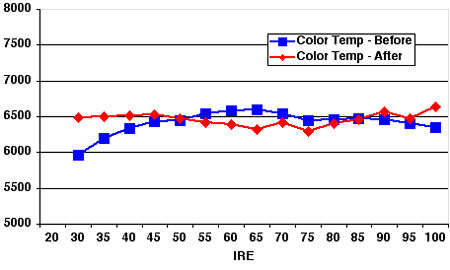
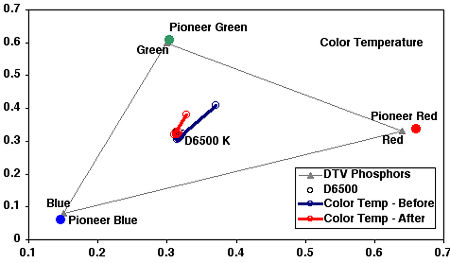
The top chart shows the gray scale of the PRO-530HD relative to its color temperature at various levels of intensity, or brightness (20 IRE is dark gray; 100 IRE is bright white). The gray scale as set by the factory, in the most accurate color-temperature mode, measures too far off the black body curve to measure a color temperature with the darkest images but is more accurate with brighter images. On our sample, the most accurate color-temperature mode was the news mode, which is highly irregular and may be a quirk with this sample. After making adjustments using the Photo Research PR-650, the gray scale measures even closer to accurate across the entire gray scale. The bottom chart shows the gray scale (or color temperature) relative to the color points of the display's red, green, and blue CRTs. Red (x=0.660, y=0.338), green (x=0.304, y=0.608), and blue (x=0.146, y=0.061) are slightly off those specified by SMPTE, as all colors are slightly oversaturated. The light output was approximately 28 foot-lamberts. The display has good DC restoration and a good color decoder. The PRO-530HD displays out to DVD's limits and, using our Leader LT-446 HD generator, is capable of resolving 720p signals out to 700 (pph) and 1080i out to 870 (pph).—GM
Mitsubishi WS-65613 (CRT, $3,800)
The Mitsubishi WS-65613 is a behemoth. It's the tallest, heaviest, and second deepest TV in the Face Off. Thankfully, you can separate the top part of the cabinet from the bottom for easier (notice I didn't say easy) installation. Commensurate with its size, it also has one of the biggest remotes and a massive amount of inputs. Although its screen isn't any bigger than that of the Toshiba or Sony CRT TV, it seems bigger.
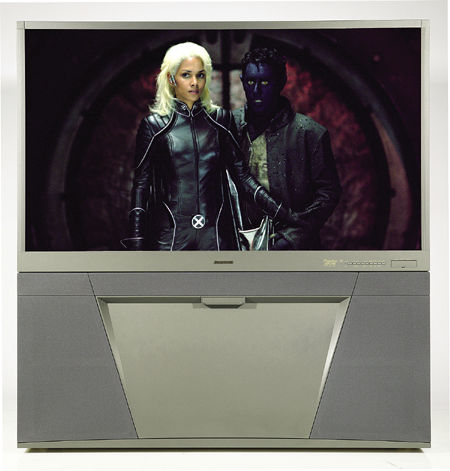
The WS-65613 is one of only a few sets that did significantly better on day two than on day one. Strangely, the comments didn't reflect this, only the scores. Comments before calibration mimicked those after calibration: the same strengths, the same weaknesses. Like all of the CRT sets, people felt that the WS-65613 looked far better when they sat farther back (at a more-appropriate viewing distance).
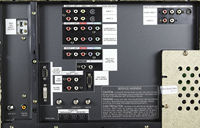 Beyond that, people didn't have many negative things to say about the WS-65613, but they didn't say many positive things, either. It didn't really do much wrong, but it didn't excel at anything (other than size and input options). About half of our reviewers commented on the good black level, although some of them thought that it may have been crushing blacks slightly. Glenn and Amy mentioned that there was a slight amount of video noise but far less than they saw on some of the other sets, and it was less noticeable from farther away. A few reviewers felt that dark scenes looked very red, which they didn't like. Overall, though, the WS-65613 calibrated well, except at the bottom of the gray scale.
Beyond that, people didn't have many negative things to say about the WS-65613, but they didn't say many positive things, either. It didn't really do much wrong, but it didn't excel at anything (other than size and input options). About half of our reviewers commented on the good black level, although some of them thought that it may have been crushing blacks slightly. Glenn and Amy mentioned that there was a slight amount of video noise but far less than they saw on some of the other sets, and it was less noticeable from farther away. A few reviewers felt that dark scenes looked very red, which they didn't like. Overall, though, the WS-65613 calibrated well, except at the bottom of the gray scale.
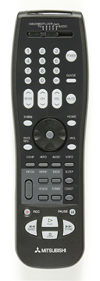 As I measured it, I noticed the one thing that everyone noticed: the color. Each of the three color points is slightly off from those specified by SMPTE. Most of the TVs in this Face Off had one or two points off, but the Mitsubishi missed with all three. This caused Amy to remark that the colors seemed cartoonish and that the grass in the Monday Night Football clip looked like Kentucky Bluegrass. Ironically, this is exactly what Invesco Field uses—four different kinds, in fact (yes, I looked it up). I think she was implying that the WS-65613's green looked more blue than that of the other TVs. Not all of the reviewers were averse to the extra color. On day two, Jerry felt that the WS-65613 was "very watchable" and that "the color saturation made it that much more engaging."
As I measured it, I noticed the one thing that everyone noticed: the color. Each of the three color points is slightly off from those specified by SMPTE. Most of the TVs in this Face Off had one or two points off, but the Mitsubishi missed with all three. This caused Amy to remark that the colors seemed cartoonish and that the grass in the Monday Night Football clip looked like Kentucky Bluegrass. Ironically, this is exactly what Invesco Field uses—four different kinds, in fact (yes, I looked it up). I think she was implying that the WS-65613's green looked more blue than that of the other TVs. Not all of the reviewers were averse to the extra color. On day two, Jerry felt that the WS-65613 was "very watchable" and that "the color saturation made it that much more engaging."
While most of the reviewers (including those who were shorter than the TV) felt that the Mitsubishi looked
as ungainly as it surely was, Maureen thought that it was a great size for a home theater. Jerry, who ranked it third on day two, also liked the thin, black bezel around the screen. He remarked that this "allows for improved focus on the screen" but then added, "Otherwise, the cabinet is rather bland." The remote has buttons for everything except direct-input access and is only partially backlit.
The WS-65613 also fell in the middle of the pack price-wise. It costs $3,800 and tied for biggest screen size. Like the other two 65-inchers, it has an HDTV tuner. Throw in the vast array of input options, and it's not a bad deal, especially when you consider all of the extra mass that the WS-65613 gives you.

WS-65613 65-Inch HDTV $3,800
Mitsubishi Digital Electronics
(949) 465-6000
www.mitsubishi-tv.com
Dealer Locator Code MSU
HT Labs Measures: Mitsubishi WS-65613 HDTV
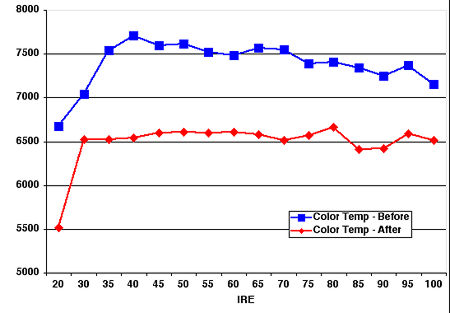
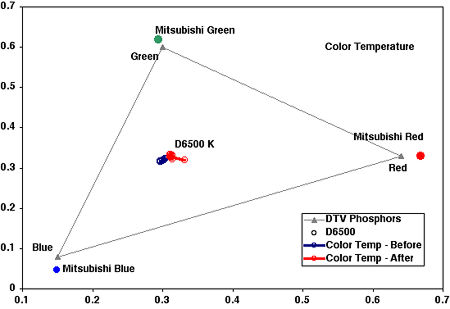
The top chart shows the gray scale of the WS-65613 relative to its color temperature at various levels of intensity, or brightness (20 IRE is dark gray; 100 IRE is bright white). The gray scale as set by the factory, in the low 6500K color-temperature mode, measures slightly blue with dark images and gets even bluer with brighter images. After making adjustments using the Photo Research PR-650, the gray scale dips very red with dark images but tracks quite well across the rest of the gray scale. The bottom chart shows the gray scale (or color temperature) relative to the color points of the display's red, green, and blue CRTs. Red (x=0.668, y=0.330), green (x=0.294, y=0.619), and blue (x=0.149, y=0.046) are somewhat off those specified by SMPTE. All colors are oversaturated, and blue is slightly purple. The light output was approximately 31 foot-lamberts. The display has average DC restoration and an average color decoder that pushes red slightly. The WS-65613 displays approximately 470 lines (per picture height) with NTSC sources and, using our Leader LT-446 HD generator, is capable of resolving 1080i out to 740 lines (pph). This set does not accept 720p signals.—GM
- Log in or register to post comments




























































